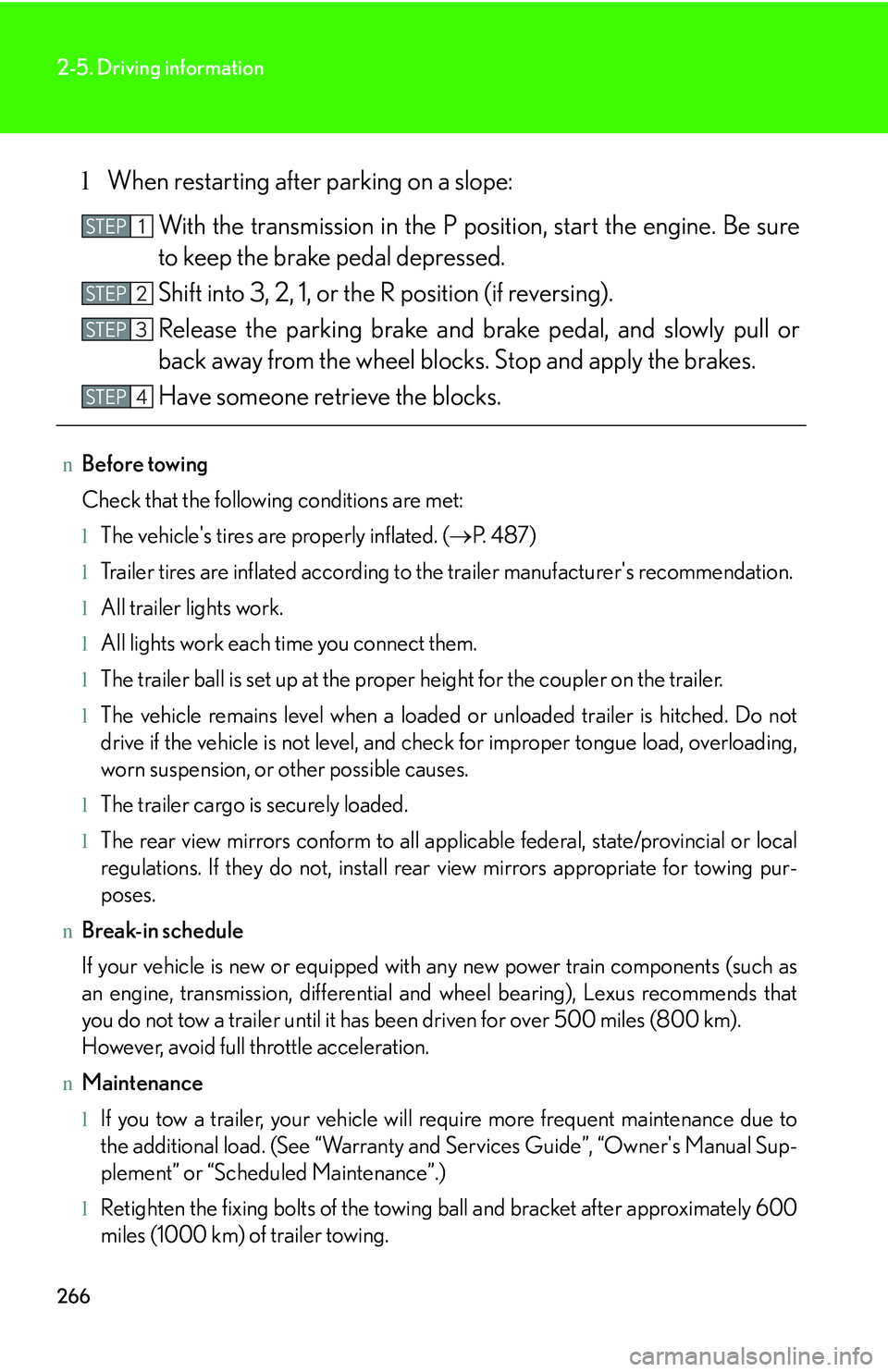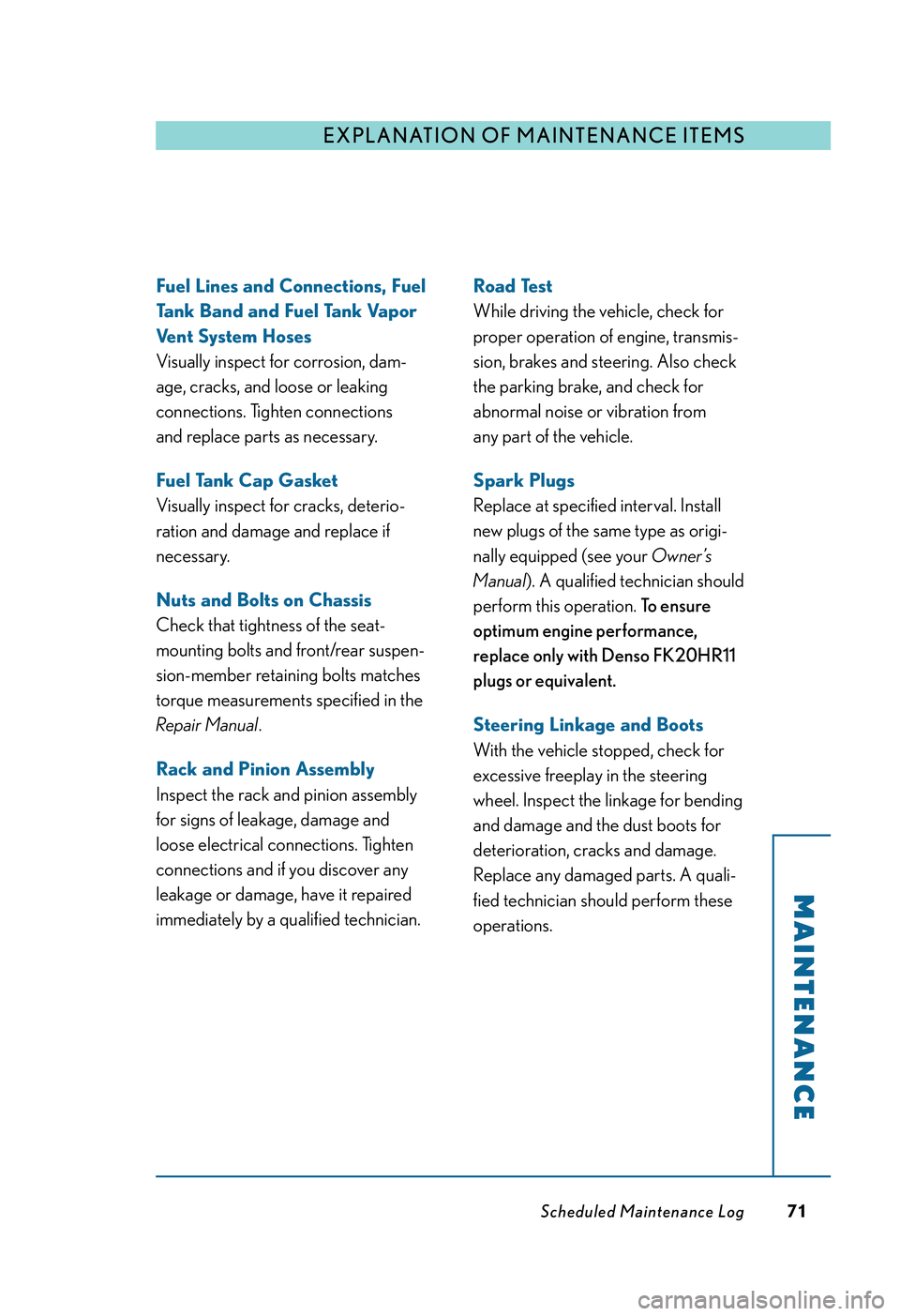wheel bolts LEXUS RX350 2011 Owners Manual
[x] Cancel search | Manufacturer: LEXUS, Model Year: 2011, Model line: RX350, Model: LEXUS RX350 2011Pages: 821, PDF Size: 13.27 MB
Page 338 of 821

266
2-5. Driving information
lWhen restarting after parking on a slope:
With the transmission in the P position, start the engine. Be sure
to keep the brake pedal depressed.
Shift into 3, 2, 1, or the R position (if reversing).
Release the parking brake and brake pedal, and slowly pull or
back away from the wheel blocks. Stop and apply the brakes.
Have someone retrieve the blocks.
nBefore towing
Check that the following conditions are met:
lThe vehicle's tires are properly inflated. (�→P. 4 8 7 )
lTrailer tires are inflated according to the trailer manufacturer's recommendation.
lAll trailer lights work.
lAll lights work each time you connect them.
lThe trailer ball is set up at the proper height for the coupler on the trailer.
lThe vehicle remains level when a loaded or unloaded trailer is hitched. Do not
drive if the vehicle is not level, and check for improper tongue load, overloading,
worn suspension, or other possible causes.
lThe trailer cargo is securely loaded.
lThe rear view mirrors conform to all applicable federal, state/provincial or local
regulations. If they do not, install rear view mirrors appropriate for towing pur-
poses.
nBreak-in schedule
If your vehicle is new or equipped with any new power train components (such as
an engine, transmission, differential and wheel bearing), Lexus recommends that
you do not tow a trailer until it has been driven for over 500 miles (800 km).
However, avoid full throttle acceleration.
nMaintenance
lIf you tow a trailer, your vehicle will require more frequent maintenance due to
the additional load. (See “Warranty and Services Guide”, “Owner's Manual Sup-
plement” or “Scheduled Maintenance”.)
lRetighten the fixing bolts of the towing ball and bracket after approximately 600
miles (1000 km) of trailer towing.
STEP1
STEP2
STEP3
STEP4
Page 643 of 821

574
5-2. Steps to take in an emergency
CAUTION
nUsing the tire jack
Improper use of the tire jack may cause the vehicle to suddenly fall off the jack,
leading to death or serious injury.
lDo not use the tire jack for any purpose other than replacing tires or installing and
removing tire chains.
lOnly use the tire jack that comes with this vehicle for replacing a flat tire.
Do not use it on other vehicles, and do not use other tire jacks for replacing tires
on this vehicle.
lAlways check that the tire jack is securely set to the jack point.
lDo not put any part of your body under the vehicle is supported by the jack.
lDo not start or run the engine while your vehicle while it is supported by the jack.
lDo not raise the vehicle while someone is in it.
lWhen raising the vehicle, do not put an object on or under the jack.
lDo not raise the vehicle to a height greater than that required to replace the tire.
lUse a jack stand if it is necessary to get under the vehicle.
Take particular care when lowering the vehicle to ensure that no one working on or
near the vehicle may be injured.
nReplacing a flat tire
Observe the following precautions to reduce the risk of death or serious injury:
lDo not touch the disc wheels or the area around the brakes immediately after the
vehicle has been driven.
After the vehicle has been driven the disc wheels and the area around the brakes
will be extremely hot. Touching these areas with hands, feet or other body parts
while changing a tire, etc. may result in burns.
lNever use oil or grease on the wheel bolts or wheel nuts.
Oil and grease may cause the wheel nuts to be excessively tightened, leading to
bolt or disc wheel damage. In addition, the oil or grease can cause the wheel nuts
to loosen and the wheel may fall off, causing a serious accident. Remove any oil or
grease from the wheel bolts or wheel nuts.
Page 810 of 821

EXPLANATION OF MAINTENANCE ITEMS
MAINTENANCE
Scheduled Maintenance Log71
Fuel Lines and Connections, Fuel
Tank Band and Fuel Tank Vapor
Vent System Hoses
Visually inspect for corrosion, dam-
age, cracks, and loose or leaking
connections. Tighten connections
and replace parts as necessary.
Fuel Tank Cap Gasket
Visually inspect for cracks, deterio-
ration and damage and replace if
necessary.
Nuts and Bolts on Chassis
Check that tightness of the seat-
mounting bolts and front/rear suspen-
sion-member retaining bolts matches
torque measurements specified in the
Repair Manual.
Rack and Pinion Assembly
Inspect the rack and pinion assembly
for signs of leakage, damage and
loose electrical connections. Tighten
connections and if you discover any
leakage or damage, have it repaired
immediately by a qualified technician.
Road Test
While driving the vehicle, check for
proper operation of engine, transmis-
sion, brakes and steering. Also check
the parking brake, and check for
abnormal noise or vibration from
any part of the vehicle.
Spark Plugs
Replace at specified interval. Install
new plugs of the same type as origi-
nally equipped (see your Owner’s
Manual). A qualified technician should
perform this operation. To ensure
optimum engine performance,
replace only with Denso FK20HR11
plugs or equivalent.
Steering Linkage and Boots
With the vehicle stopped, check for
excessive freeplay in the steering
wheel. Inspect the linkage for bending
and damage and the dust boots for
deterioration, cracks and damage.
Replace any damaged parts. A quali-
fied technician should perform these
operations.
89577_2011RX350_48-80j_R1.qxd8/6/107:52PMPage71